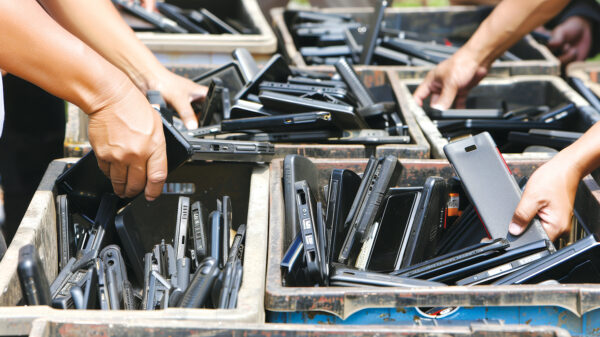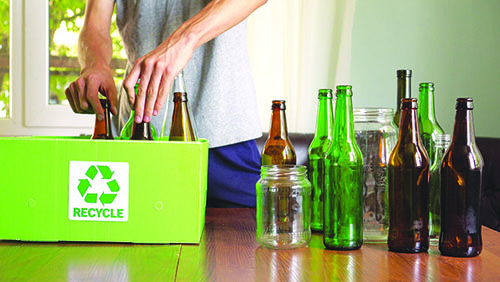by MARY M. COX
Manufacturer List
|
Optical sorting technology, also called digital sorting, is an automated process that sorts materials found in waste and recycling operations. Depending on the type of technology involved, optical sorters can recognize material color, size, shape, structural properties and chemical composition. Compared to manual sorting, oftentimes subjective and inconsistent, optical sorting can help maximize throughput, increase yields and reduce labor costs. An optical sorter compares objects to user-defined accept/reject criteria, which is then used to identify and sort material as required.
A division of the CP Group, MSS designs, engineers, manufactures, installs and services automated optical sorting equipment for the recycling and waste management industries. Applications are available for single-commodity facilities processing plastics, paper, glass, e-scrap, metals, beverage cartons, etc. or commingled recyclables and mixed waste plants for single-stream, dual-stream, municipal solid waste (MSW), refuse derived fuel (RDF), commercial and industrial (C&I), construction and demolition (C&D) and more.
 MSS recently introduced two new sensor-based technologies for MRF and MSW applications: Cirrus™ and Metalsort™. “Like all MSS technologies, both accurately sort using advanced identification algorithms and corresponding precise high-pressure air jets,” stated Felix Hottenstein, sales director.
MSS recently introduced two new sensor-based technologies for MRF and MSW applications: Cirrus™ and Metalsort™. “Like all MSS technologies, both accurately sort using advanced identification algorithms and corresponding precise high-pressure air jets,” stated Felix Hottenstein, sales director.
Cirrus utilizes a new high-resolution near-infrared (NIR) and color sensor array providing accurate sorting of different material types. In MRFs, plastics such as PET, HDPE Natural, HDPE Colored, PP and PS are sorted efficiently from 3D container streams. Also, contaminants (non-fiber) are removed from mixed paper and newspaper commodities to provide the highest product purities. In MSW applications, Cirrus is utilized to extract mixed paper and plastic film from mechanically pre-sorted 2D streams and plastic containers from the 3D fraction.
Metalsort is based on induction sensor coils. This all-metal detector for ferrous, nonferrous and stainless steel can be integrated into a processing line as a stand-alone module or as an upgrade to the Cirrus to recover metals from the various streams present in MRF and MSW processing facilities.
Hottenstein said, “The exact sensor configuration is tailored to each specific processing application. A user-friendly touchscreen interface allows the operator to change sort recipes on the fly with the touch of a button.” All MSS units are offered in various sizes between 32” and 96”.
“Products by Pellenc ST are designed to help recover the most value from material via maximum performance. We can find the right solution in every recycling environment, whether in sorting facilities, recycling facilities, or special markets such as electronic waste and RDF,” explained Mike Roberts, head of sales, Pellenc North America.
 Roberts explained, “Using NIR and vision technologies, the Mistral machine is our most sought-after product. It is equipped with the most advanced technology in the optical sorting industry. The Mistral is used in every application in recycling: MSW, MRF, RDF, C&D, industrial, WEEE, PET, film, paper, plastics, and organics. With one machine you can sort it all. The Mistral’s unique focus lightening system and spectrometer are designed to bring back two to four times the amount of information to the optical sensors, when compared to other optical sorters on the market. This information advantage provides the optimum in precision, in sorting materials. Over 1,000 machines are installed in over 40 countries and the Mistral has proven its performance and reliability. We build every machine from the ground up.”
Roberts explained, “Using NIR and vision technologies, the Mistral machine is our most sought-after product. It is equipped with the most advanced technology in the optical sorting industry. The Mistral is used in every application in recycling: MSW, MRF, RDF, C&D, industrial, WEEE, PET, film, paper, plastics, and organics. With one machine you can sort it all. The Mistral’s unique focus lightening system and spectrometer are designed to bring back two to four times the amount of information to the optical sensors, when compared to other optical sorters on the market. This information advantage provides the optimum in precision, in sorting materials. Over 1,000 machines are installed in over 40 countries and the Mistral has proven its performance and reliability. We build every machine from the ground up.”
On the support side, Roberts noted, “Pellenc does more than just sell a product. We offer technical guidance to maximize the use of the optical sorting machines with each client. Everything is planned, built, and delivered from our home office then followed up by a full installation and implementation service performed at the customer’s site. Pellenc also offers the highest level of support to clients with a 24/7 direct phone line, remote maintenance – this is where more than 85 percent of issues are resolved – a team of local technicians, local spare parts, and service packages to ensure that our machines always function properly in their environment.”
 Steinert has provided complex sorting solutions for more than 125 years. “Using sophisticated magnet and sensor technology, we offer individual equipment, full solutions, parts and service to our customers,” Jason Miller, standard equipment sales manager – North America, stated. The company’s two sorting products include the Steinert XSS T, which uses x-ray transmission technology to recognize different material densities containing halogens and organic components, and the Steinert XSS F, which uses s-ray fluorescence to differentiate alloys, metals and ores based on their surfaces and elemental composition. The sorting technology involves a dual energy system to determine material density while overcoming the effects of thickness and shape. The process can accommodate material ranging in size from 10 to 200mm.
Steinert has provided complex sorting solutions for more than 125 years. “Using sophisticated magnet and sensor technology, we offer individual equipment, full solutions, parts and service to our customers,” Jason Miller, standard equipment sales manager – North America, stated. The company’s two sorting products include the Steinert XSS T, which uses x-ray transmission technology to recognize different material densities containing halogens and organic components, and the Steinert XSS F, which uses s-ray fluorescence to differentiate alloys, metals and ores based on their surfaces and elemental composition. The sorting technology involves a dual energy system to determine material density while overcoming the effects of thickness and shape. The process can accommodate material ranging in size from 10 to 200mm.
Miller said, “Mixed metal commodities are facing numerous challenges in today’s market, including the low rate of domestic use, inconsistent demand and price, discounted metallic valuations based on content and challenges with international import regulators. Process equipment and improvements can help companies to increase metals revenue from existing feedstock, diversify product offerings and allow for rapid adjustment in changing market conditions relative to factors such as regulation, supply and demand of certain products.
“Companies can increase the purity of their products and increase revenue via the Steinert x-ray sorting equipment because it combines the power of x-ray technology with a system designed to identify and separate material based on its elemental composition or material density. Every individual particle in the material flow is recognized and classified, increasing the range of possibilities for sorting mixed materials,” Miller explained.
Published in the January 2015 Edition of American Recycler News








